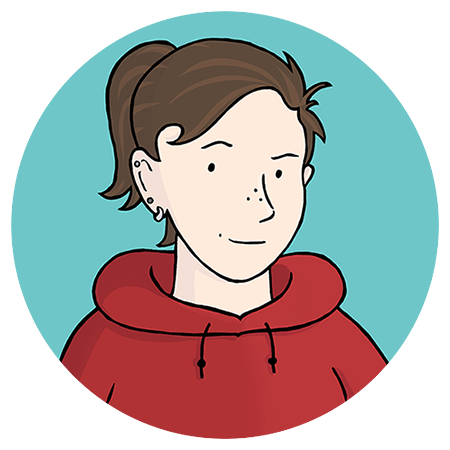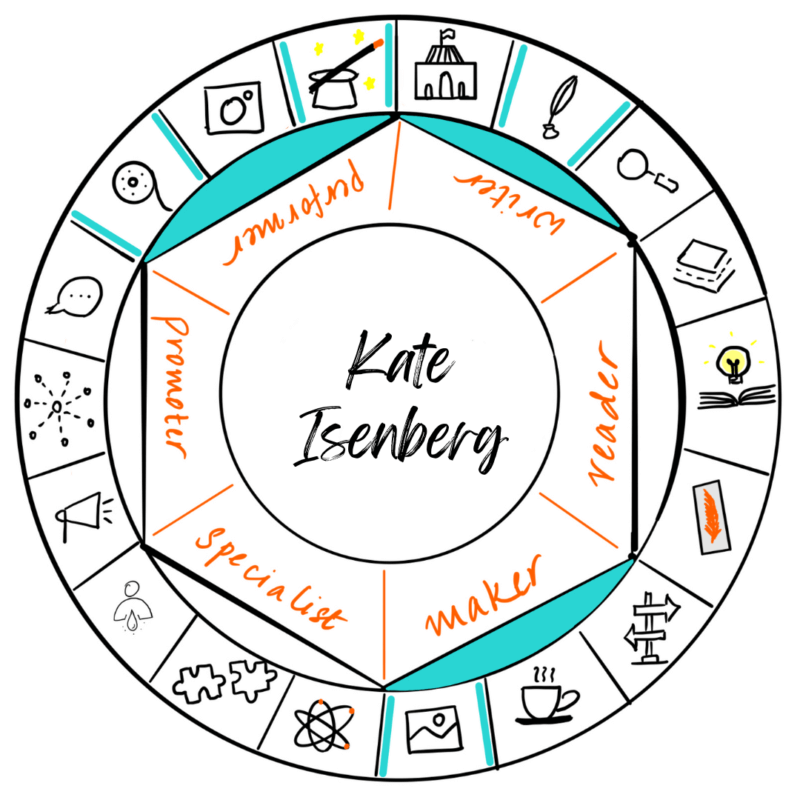Happy Friday, friend! You know how i love reaching out to people who would talk about their craft with me? I found a cartoonist! I have the pleasure of sharing this conversation with Kate Isenberg who shares her art on Instagram.
The Life of a Cartoonist: An interview with Kate Isenberg
Hi Kate! Welcome to Armed with A Book. Please tell me and my readers a bit about yourself.

I’m a cartoonist living in the San Francisco Bay Area, with my dog, Cleo. I studied English at Harvard and animation at UCLA Animation Workshop, where I got my MFA. My drawings have appeared in magazines like The New Yorker, Air Mail, Alta, and Narrative. Besides drawing single-panel “gag” cartoons like those found in The New Yorker, I also draw a comic strip called Stewball. Stewball is an anxious half-horse, half-unicorn, who walks on two legs and longs to be a successful poet.
In what ways do you pursue creativity?
Being a cartoonist is my oldest creative pursuit; I began drawing funny pictures of animals doing people things—mice playing soccer, bees going to work—when I was quite small. This love of drawing is really a love of story, which is my deepest love of all. I grew up reading and being read to by my parents: I well remember my mom buying my brother and me Turkish delight candy to eat while she read us the chapter about Edmund eating Turkish delight with the White Witch in C.S. Lewis’s The Lion, the Witch, and the Wardobe. For me, stories have always been real enough to taste.
In college, I studied English so I could understand how writers from Shakespeare to Toni Morrison use language to communicate their particular insights on the human condition. I went to graduate school for animation so I could make my animal drawings walk, talk, and boogie—but also so I could tell my own stories on screen.
In addition, I am a singer-songwriter. My main instrument is guitar, but I also play mandolin and violin. I have released two studio albums and performed at venues around the US. I now do it more for fun than professionalism, backing up friends on harmonies or joining an open mic. Music is community! It’s also a great tool for animation, which is a deeply musical art. Every movement we make is rooted in rhythm. Being a musician has enabled me to attune to the rhythms of the natural world, as well as nuances in the way people communicate their thoughts and emotions. Also, knowing how to record and edit music and dialogue has helped me immensely as a filmmaker, so that I can record actors’ performances of my animated characters, as well as work creatively with music and sound effects that help bring animated worlds to life.
We connected on Instagram when I came across your work. What’s the best part about being a cartoonist?
Our world is fraught with stressors: political tribalism, racism, homophobia, economic inequality, environmental destruction, rising living costs, the looming impact of AI. Being a cartoonist allows me to reflect on the world’s very real problems through the lens of absurdity. When I can make myself laugh at the craziness of the world, and maybe even give another person the chance to laugh or roll their eyes along with me, it’s a relief and an opportunity to form community instead of worrying alone. And sometimes, cartoons allow me to capture something purely whimsical, joyful, or funny about the world, and that’s equally helpful to me, and hopefully to others, as well.
We need stories to make sense of our lives and our world; we need comedy to gain a psychological advantage over our struggles and, simply, to remind us of joy.
I adore your cat cartoons! Are there any particular themes or objects that you like to draw about?
Thank you! Cats are a newer comedic discovery for me, as I did not grow up with a cat. I think cats are inherently comedic. For example: their serious, sometimes pissy facial expressions; their emotional manipulations; their tails and their butts: all these qualities lend themselves to cartoons. I am also a huge fan of drawing frogs. Their wide eyes, big mouths, bloated throat sacs, and webbed feet are, to me, inherently comedic.
As a literature nerd, I love finding ways to poke fun at classic works of art in my cartoons: the Bible, Greek myths, Shakespeare. Fairy tales are familiar ground for cartoonists, for a good reason: they’re cultural metaphors, meant to be reimagined as times change.
Do you recall the first cartoon you ever drew?
I was heavily influenced by children’s book illustrators like William Steig, Richard Scarry, and Garth Williams. One of my earliest was a “worker bee” with a briefcase, going to the office. I was maybe four or five. Around age six, I drew an elaborate circus parade led by a marching band. It spanned three different pieces of paper, taped together. When the principal hung it in the school office I was pretty sure I had already made it to the big leagues as a cartoonist!


How do you find inspiration for your comic strips?
Life is inspiration. A few years ago, I was contemplating attending ComicCon, in San Diego. As a newer cartoonist, I was a little nervous about staying confident in my own work when surrounded by so many cartoonists, some of them with much more experience and technical skill. In the end I decided my worries were kind of funny. They inspired a Stewball comic about a “ComicCon” for aspiring poets: Poetry-Con, where everyone is cosplaying as Shakespeare.
Tension, conflict, and struggle are the seeds of storytelling. Imagining the character who must overcome a certain struggle (whether it’s battling a dragon or confronting internal demons), and then imagining how that character changes in confronting the challenge, is at the core of most films, TV series, comic strips, and novels that I love.
For someone who may not know what they are creative in, do you have any suggestions on how they can find out?
I believe that every person is intuitively creative. As kids, human beings make up stories, imaginary worlds, songs, “nonsense” rhymes, and doodles. As we get older and more self-conscious, many of us judge our creativity (as “good” or “bad” compared with someone else’s), which stifles it. We have to set that judgy voice aside to allow ourselves to play, without knowing what we’ll create or whether we will think it’s good, or whether anyone else will appreciate it. We can also appreciate creativity in diverse forms, including (but not limited to) cooking, gardening, event-planning, problem-solving, listening, communicating skillfully with other people, nurturing relationships.
I don’t have a formal religious tradition or practice, but I’m aware of a line from the Gospel of Matthew: “For where your treasure is, there your heart will be also.” A textbook I had in college (Other Criteria: Confrontations with Twentieth-Century Art, by Leo Steinberg) changed this quote to “Where your treasure is, there your art will be also.” I interpret this to mean that what matters to us, personally, is often the wellspring of our creativity.
What we treasure—the experiences that have been meaningful to us in our lives, the pieces of art that have moved us emotionally and stay with us through the years—hold clues to the kind of art and subject matter that we will find resonance in, if we explore those clues with curiosity. Before I picked up a guitar, I was obsessed with the Indigo Girls, Tracy Chapman, the Police, and REM; I fell asleep many nights listening to Simon and Garfunkel, picking out the harmonies. By immersing myself in that medium as a listener, I learned to love it in an intuitive and also nuanced way. Later, when I wrote my own songs, I drew on that detailed listening. Although I came to write songs different from those initial inspirations, they gave me a place and a reason to start.
So now, when a work of art moves me intensely, I know that I likely have creative potential in that arena. I may never explore it fully, as there’s only so much time in the day. But I’ve learned to respect my passions as clues to subjects and media I want to explore in my own work.
How does burnout manifest in a professional setting? Have you experienced it?
As a cartoonist, I have to refill the well: to find new images and subjects to draw about. Often this means leaving the house, which, as a homebody, can be a challenge for me!
You are also a teacher. You have taught story development, digital animation techniques as well as sound design. What do you enjoy most about teaching?
I love witnessing someone else develop confidence and skill in their creative expression. I have experienced how profoundly empowering education can be (whether in a classroom, in relationship with a mentor, or self-taught from books or YouTube). When I learn, I have to be patient with myself and have hope that I can make a start, and then make progress. Patience and hope are precious things. So are will and determination. I think it’s beautiful when a student of any age summons those courageous qualities to learn something new and develop their skill.
Having been blessed with incredible teachers in my life—family members, summer-camp counselors, fellow-artists, and friends as well as teachers and professors—I appreciate the chance to give to other people the gifts of empathy, encouragement, constructive critique, and belief in themselves that have allowed me to progress as an artist and thinker.
And to teach in the area of storytelling allows me to live my belief that storytelling is at the heart of human empathy. Communication of our stories can transform our lives and others’ lives for the better. By teaching these arts, I help others remember how vital these practices are, how they endow and reveal meaning, how they allow us to connect with other people (real or imagined).
What are some books about creativity that you find inspiring?
I’m inspired by biographies, articles, and interviews featuring artists who persevered even when they faced discouragement. Above the desk where I draw cartoons is a quote from the filmmaker Vince Gilligan, who created the TV series Breaking Bad and co-created Better Call Saul. His advice to artists was to “gird up your loins for failure, because you will fail more often than you will succeed. And, given that information, go down swinging at something that is important.”
These examples remind me to create work that is important to me and to support others whose work I love and that I think deserves a wider audience. Rejection or seeming indifference are common in creative pursuits, but they don’t need to be the end of the story. As long as you keep going, the story keeps going.
Is there anything else you would like to add?
I enjoy sharing community with other artists. Please find me on Instagram at @thekateisenberg. Thank you for the opportunity!

Thank you for reading to the end of the post. I hope you enjoyed this interview. Be sure to share it with your friends who love art!

Be First to Comment